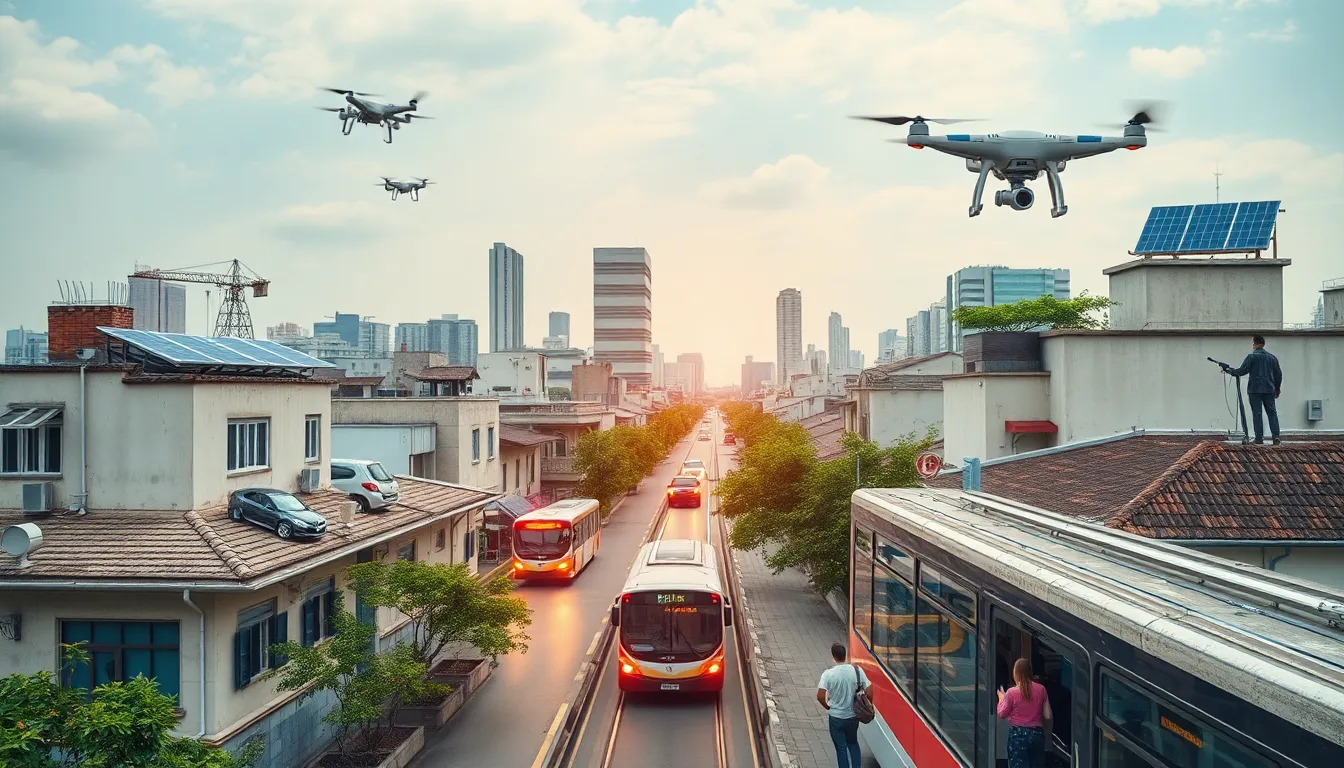Ever wondered what keeps the world spinning smoothly? Spoiler alert: it’s not magic but infrastructure! From the roads that lead to your favorite coffee shop to the bridges that connect cities, infrastructure is the unsung hero of modern life. It’s the backbone of economies and the silent partner in our daily adventures.
Table of Contents
ToggleOverview of World Infrastructural Insights
Infrastructure forms the backbone of economies and daily activities. Understanding its components provides insights into its vital role in societal progress.
Definition of Infrastructure
Infrastructure encompasses the basic physical systems and structures needed for a society to function. Key elements include transportation networks, water supply systems, sewage facilities, and energy distribution. These resources serve various sectors, ensuring that cities and communities operate smoothly. A robust infrastructure facilitates not only economic activities but also enhances the quality of life for residents. Recognition of its broad scope is essential for effective planning and development.
Importance of Infrastructure in Development
Infrastructure significantly influences economic growth and development. Access to reliable transport systems accelerates trade, while efficient energy supply underpins industrial productivity. Quality infrastructure attracts investments, providing businesses with the resources necessary for expansion. Communities benefit from improved health services linked to reliable water and sanitation systems. Additionally, infrastructure supports education by enhancing access to learning facilities. As regions develop, prioritizing infrastructure becomes critical for sustainable advancement and long-term prosperity.
Global Infrastructure Trends

Infrastructure trends reflect the ongoing evolution in technology and sustainability practices. Adapting to these shifts is crucial for future success.
Emerging Technologies
Smart city initiatives increasingly rely on digital infrastructure. IoT (Internet of Things) devices enhance data collection, allowing for improved resource management. Autonomous vehicles promise to revolutionize transportation networks. Drones contribute to efficient delivery systems, particularly in urban areas. AI (artificial intelligence) helps optimize traffic flow and energy usage. These technologies provide innovative solutions that address the needs of modern societies. Projects integrating these advancements demonstrate enhanced operational efficiency and improved user experience.
Sustainability Practices
Sustainability practices in infrastructure design prioritizes eco-friendly solutions. Integrating renewable energy sources, such as solar and wind, reduces dependence on fossil fuels. Green building initiatives focus on reducing carbon footprints, emphasizing energy-efficient materials and construction techniques. Water conservation systems play a vital role in maintaining resource availability. Circular economy principles encourage recycling and reuse, minimizing waste generation. Furthermore, public transportation development aims to lower emissions and alleviate congestion in urban centers. These practices are essential for promoting resilience and adaptability in infrastructure planning.
Regional Infrastructure Developments
Infrastructure developments across different regions highlight trends that shape global connectivity and economic growth.
North America
In North America, significant infrastructure projects focus on modernizing aging systems. The Biden administration’s bipartisan infrastructure law allocates $1.2 trillion, targeting roads, bridges, and broadband expansion. Investments in renewable energy projects reach new levels, promoting cleaner options for power generation. Smart city initiatives, harnessing IoT technologies, aim to enhance urban planning and transportation efficiency. These commitments reflect a commitment to sustainability and resilience in infrastructure design, crucial for maintaining economic competition.
Asia-Pacific
Asia-Pacific nations exhibit rapid infrastructure growth, driven by urbanization and economic ambitions. China’s Belt and Road Initiative continues to expand, linking multiple countries through improved transport networks. Major metropolitan areas like Tokyo and Sydney invest heavily in public transit systems, aiming to reduce congestion and enhance commuter experiences. Additionally, renewable energy projects gain traction, with countries like India focusing on solar energy to meet increasing demands. These developments emphasize a strong push towards sustainable infrastructure, responding to both population growth and environmental challenges.
Europe
European infrastructure focuses on sustainability and integration among member states. The European Union aims to enhance transport links via the Trans-European Transport Network, facilitating seamless travel and trade. Investments in high-speed rail systems support reduced travel times and lower carbon emissions. Urban areas increasingly adopt green building practices, promoting energy efficiency and sustainable living. Additionally, digital infrastructure initiatives prioritize broadband access in rural and underserved regions. By aiming for a balanced approach, Europe seeks to create robust frameworks that support both economic growth and environmental sustainability.
Challenges Facing Global Infrastructure
Global infrastructure faces significant challenges that hinder progress and development. Various factors contribute to these complexities, impacting economies worldwide.
Funding and Investment
Funding gaps impede infrastructure development globally. Approximately $15 trillion is needed to meet infrastructure demands by 2040, yet investment levels currently fall short. Public-private partnerships have emerged as a solution, providing innovative financing while reducing risks. Governments and private entities must collaborate to allocate resources effectively, maximizing the potential of infrastructure projects. Countries like the United States leverage federal funding to modernize systems, but local governments also play a crucial role in securing additional investment sources.
Climate Change Impacts
Climate change poses a critical threat to infrastructure integrity. Rising temperatures and extreme weather events increase maintenance costs and shorten lifespans of infrastructure assets. For instance, flooding can damage roads, bridges, and critical facilities, necessitating costly repairs. A proactive approach to climate-resilient design is essential for long-term sustainability, integrating adaptive solutions into new projects. Regions prioritizing green infrastructure, such as expanded flood management and energy-efficient solutions, can mitigate risks and promote resilience in their communities.
Future of World Infrastructure
Future infrastructure depends heavily on innovative technologies and strategic policies. Embracing advancements ensures stronger and smarter systems.
Innovations and Solutions
Emerging technologies transform infrastructure development. Smart city initiatives integrate Internet of Things devices, enhancing efficiency in urban management. Autonomous vehicles promise improved transportation logistics, while drones optimize delivery services and data collection. Utilizing artificial intelligence leads to superior resource allocation and management. Renewable energy integration showcases innovations in sustainability, allowing for eco-friendly energy generation. Green building initiatives focus on sustainable materials, which minimize environmental impact. Water conservation systems leverage smart technologies, promoting efficient usage alongside public transportation development. These innovations contribute significantly to making infrastructure resilient and adaptable in a rapidly changing world.
Policy Recommendations
Strategic policies guide successful infrastructure implementation. Prioritizing investment in public-private partnerships fosters innovative financing solutions. These collaborations bridge funding gaps and mitigate risks associated with infrastructure projects. Governments must emphasize climate-resilient design to counter the adverse effects of climate change. Regulations promoting sustainable practices facilitate eco-friendly infrastructure development. Policymakers should allocate resources toward smart city projects, ensuring that urban planning aligns with technological advancements. Incentives for renewable energy projects encourage investments in sustainable infrastructure. Implementing comprehensive infrastructure planning is crucial for tackling current issues while supporting long-term growth. Effective policies must address the pressing infrastructure demands that communities face today.
The future of global infrastructure hinges on innovation and strategic planning. By embracing emerging technologies and sustainable practices, societies can create resilient systems that meet modern demands. Public-private partnerships will play a crucial role in addressing funding gaps and ensuring that infrastructure projects are both effective and environmentally friendly.
As communities continue to evolve, the focus must remain on integrating adaptive solutions that enhance connectivity and economic growth. Prioritizing sustainable infrastructure is not just a necessity but a pathway to long-term prosperity and improved quality of life for all. The commitment to robust infrastructure development will ultimately shape the world’s future, fostering a more connected and sustainable global community.




